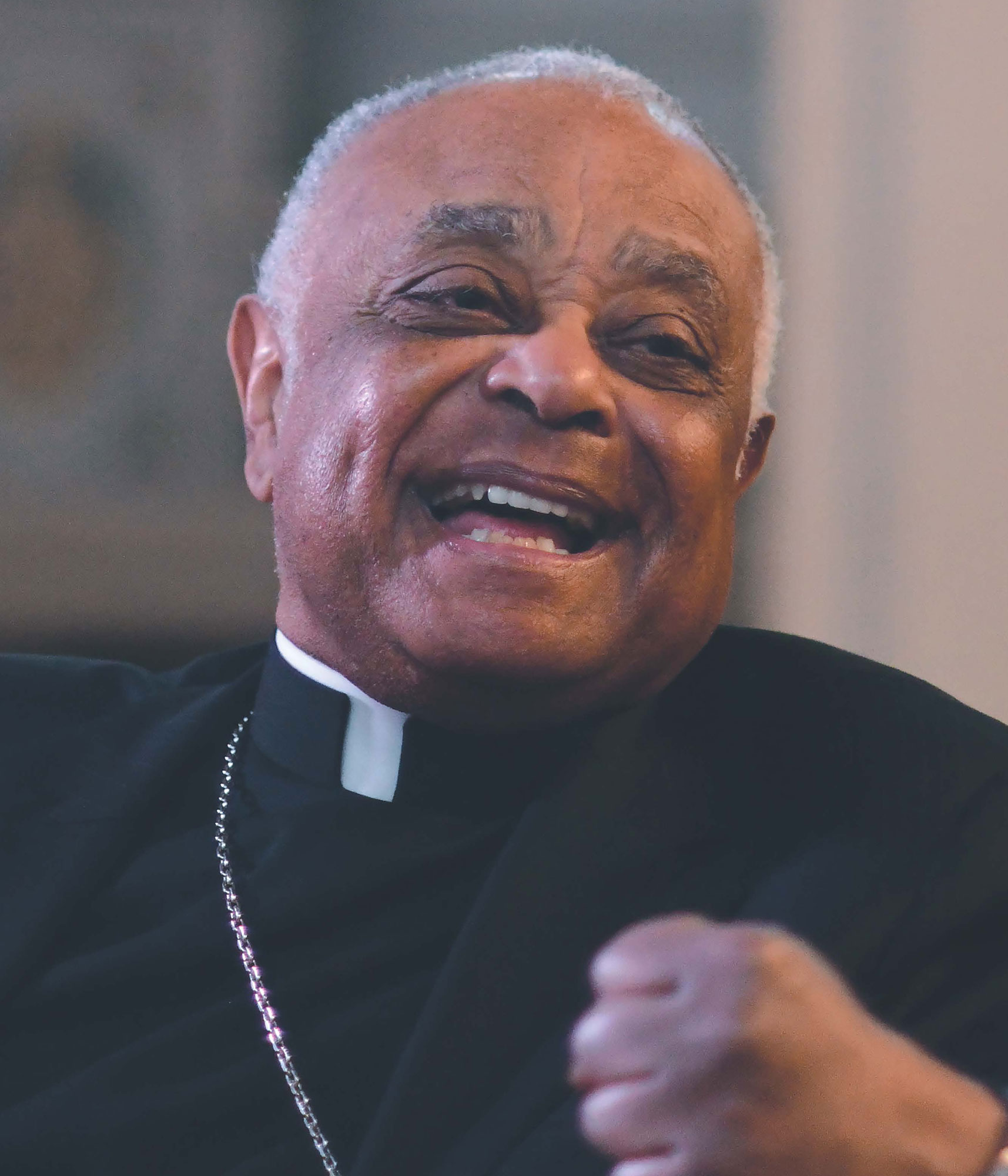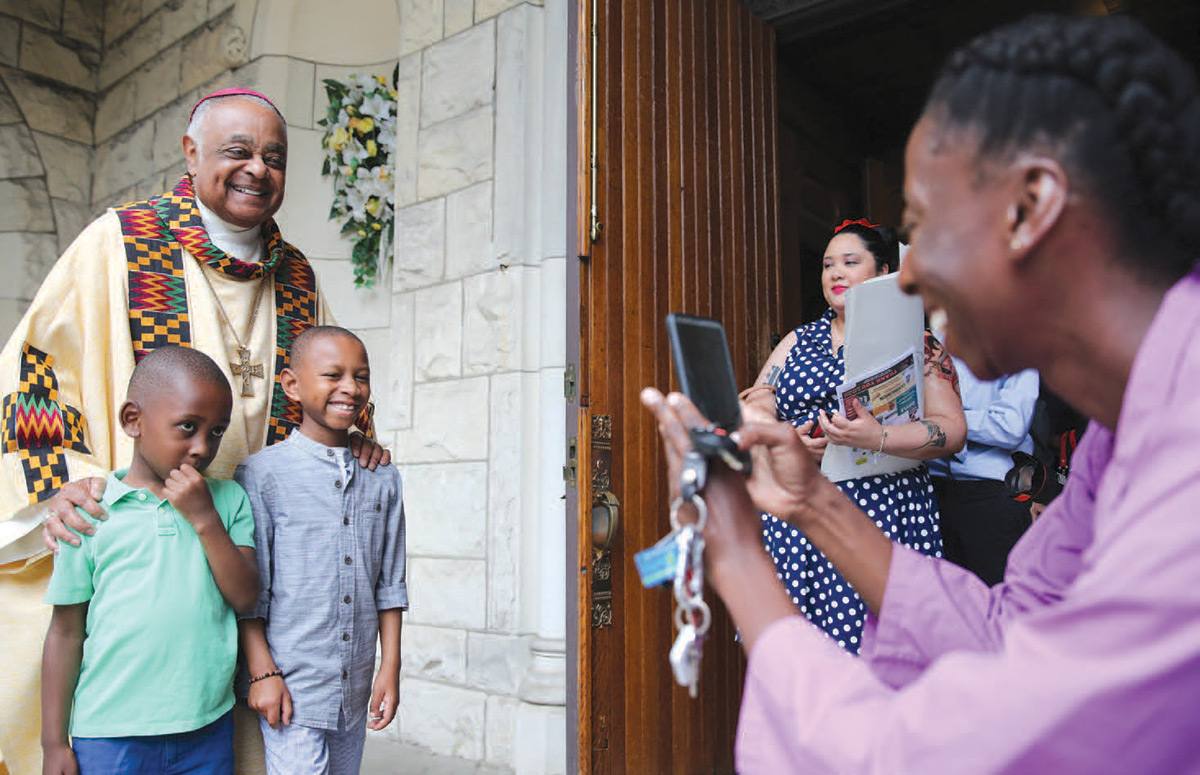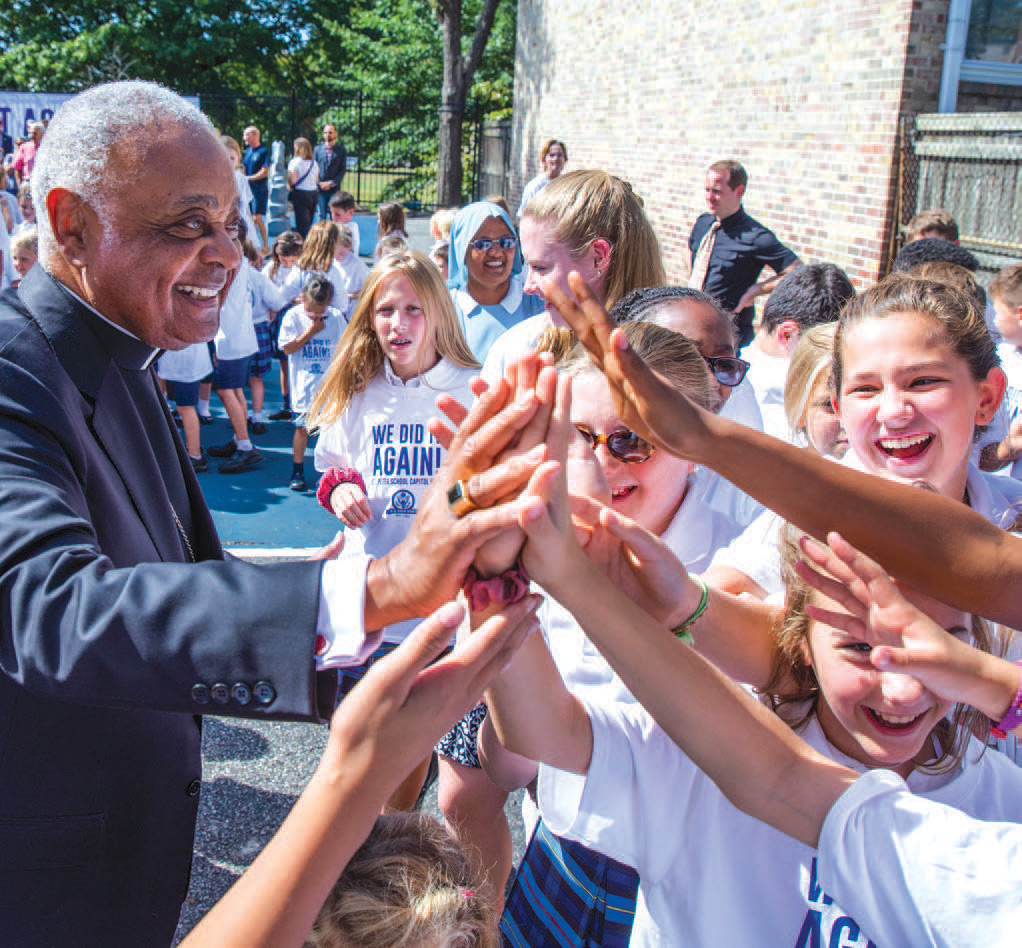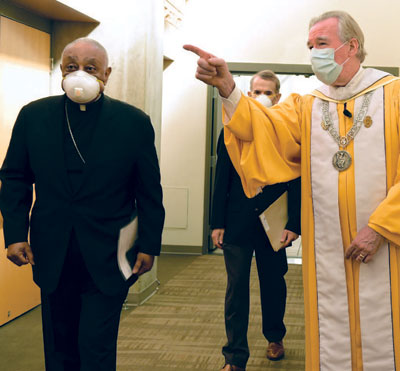
By Ellen N. Woods
CatholicU, Spring 2021
 He is the archbishop of Washington and the chancellor of Catholic University, and in November 2020, he became the Church’s first African American cardinal. His style of gentle, engaging, and decisive leadership is just right for the times.
He is the archbishop of Washington and the chancellor of Catholic University, and in November 2020, he became the Church’s first African American cardinal. His style of gentle, engaging, and decisive leadership is just right for the times.
In the fall of 1958, 11-year-old Wilton Gregory entered 6th grade at Saint Carthage School. He and his younger sisters Claudia and Elaine were new to the small Catholic school on the South Side of Chicago. “Mesmerized” by the kindness and compassion of the priests and Dominican sisters, it wasn’t but a few weeks before he announced that he might like to become a priest one day. The response from Monsignor John Hayes, pastor of the parish, came swiftly. “Wilton, it would help if you were Catholic.”
Cardinal Gregory, archbishop of Washington and chancellor of The Catholic University of America, tells that anecdote often. He delivers the punchline with a broad smile, most likely remembering his early mentors.
Along with Monsignor Hayes, there was Father Gerard Weber, the associate pastor. “I had all the energy and mischief of an 11-year-old, and they were patient, encouraging, and loving,” recalls Cardinal Gregory, who faithfully attended catechism lessons after school on Tuesdays. He was baptized by the end of the school year. His mother and sisters followed a year later.
And thus began the spiritual life and career of the first African American cardinal.

First two photos courtesy of The Georgia Bulletin. Last photo courtesy of Chicago Catholic, photo by James Kilcoyne.
Cardinal Wilton Gregory attended Quigley Preparatory Seminary South (now Saint Joseph’s College Seminary) of Loyola University and Saint Mary of the Lake Seminary in Mundelein, Ill. He was ordained a priest in the Archdiocese of Chicago in 1973. Three years later, he entered the Pontifical Liturgical Institute (Sant’Anselmo) in Rome, where he earned his doctorate in sacred liturgy in 1980.
In October 1983, Pope John Paul II appointed then-Father Gregory an auxiliary bishop of Chicago, where he served under another mentor, Cardinal Joseph Bernardin, M.A. 1951. At age 36, he became the nation’s youngest bishop at the time. Ten years later, the pope appointed him bishop of Belleville, Ill.
When he was elected president of the United States Conference of Catholic Bishops (USCCB) in 2001, he became the first African American to hold that office. He received his third assignment from Pope John Paul II in late 2004 when he was appointed Archbishop of Atlanta, a position he held for 15 years.
“The Holy Father decided he could get a little more out of me,” says the cardinal about his appointment by Pope Francis to become the seventh Archbishop of Washington in April 2019. The high-profile position in the nation’s capital puts a Catholic leader on the world stage and comes with an assumption he will wear the red cap of a cardinal. So it was not a surprise when Pope Francis announced on Oct. 25, 2020, that Archbishop Gregory would be among 13 bishops from around the world elevated to the College of Cardinals.
Still, it was a historic moment that made national and international news. The United States would have its first Black cardinal, and it came at a time of racial unrest across the nation. Cardinal-elect Gregory quickly became a sought-after media subject. The interviewers wanted to know about another often-told story from his childhood. This one seemed right for the times.
In September 1955, little Wilton Gregory took the hand of his grandmother, Etta Mae Duncan, and attended the funeral of Emmett Till. A 14-year-old Black boy from Chicago, Till was kidnapped, tortured, and lynched in Mississippi, where he was visiting family on a summer trip. His open-casket funeral would become a pivotal moment in the Civil Rights Movement.
“I was only 7 or 8. I don’t remember much, but I do remember seeing that young man’s horribly disfigured body. It left an impression,” says Cardinal Gregory. “Thousands of people came out to pay respects, and many youngsters like myself came with parents and grandparents.”
His maternal grandmother knew the importance of that moment. Duncan helped raise the Gregory children and was, says her grandson, “a prime mover in my growing up. She didn’t have a formal education, but she had an extraordinary understanding of the human heart.” It was her idea that her grandchildren attend the local Catholic school.

Archbishop Wilton Gregory greets parishioners outside the Cathedral of St. Matthew the Apostle in May 2019. (Photo by Jaclyn Lippelmann, Archdiocese of Washington)
As Cardinal Gregory’s trajectory in the Church led him to the College of Cardinals, he has stayed true to his upbringing and remembered the people who supported him along the way.
When he was ordained a bishop at Chicago’s Holy Name Cathedral, his parents, grandmother, sisters, and other family members surrounded him. “They lit up the cathedral with pride,” he says. Also present were Monsignor Hayes and Father Weber. They became lifelong friends of the Gregory family.
During his installation as archbishop of Washington in May 2019, the Basilica of the National Shrine of the Immaculate Conception was filled with supporters from the large circle of his priestly life, and Elaine and Claudia were front and center. The sisters always knew they would be there if and when the call came from Rome. The COVID-19 pandemic had other plans.
There would be no invited guests. Cardinal-elect Gregory was tested for COVID-19 prior to leaving for Rome in November 2020 and again when he arrived. He then quarantined for 10 days at the residence where the pope lives, Domus Sanctae Marthae. His meals were left outside his door. He tested negative again just before the consistory at St. Peter’s Basilica, where he and the others were elevated in a scaled-back, socially distanced ceremony that included large screens showing the faces of cardinals from across the globe attending virtually in the now-familiar checkerboard of squares.
In his homily, Pope Francis referenced the story of Jesus and the 12 Apostles on the road to Jerusalem (Mark 10:32–45), where Jesus teaches: “For the Son of Man did not come to be served but to serve and to give his life as a ransom for many.” Pope Francis cautioned the new cardinals, “The scarlet of a cardinal’s robes, which is the color of blood, can, for a worldly spirit, become the color of a secular ‘eminence.’ In that case, you will no longer be a shepherd who is close to his people. You will simply think that you are an ‘eminence.’ Once you feel that way, you are already off the road.”
By all accounts and by his own account, Cardinal Gregory treasures his role of shepherd far more than his title of “your eminence.”
“The part of my job that I absolutely love and would not abandon for anything is being with people in prayer, in the places they live, worship, and go to school,” he says. “It is important that the archbishop not be a name or a title but ‘the pastor who celebrates Mass with us.’”
Cardinal Gregory recalls another mentor. Father Myles Patrick McDonnell was the pastor of Our Lady of Perpetual Help in Glenview, Ill., where Cardinal Gregory served as associate pastor just after his ordination to the priesthood. “He was a priestly model. The one thing he required of me and the other two associate pastors was that we stood outside before and after Masses. He said those are the moments that people encounter you and he was right. That’s when you hear, ‘Can you pray for my father? He is going to have surgery.’ Or ‘I’m hoping to have a promotion.’ Or ‘My son is heading off to college. Can you say a little prayer for him?’ It’s a connecting moment and if you are not there, you miss the moment.”
The Archdiocese of Washington (ADW) is large and diverse with 655,000 parishioners who worship in 139 parishes in Washington, D.C., and five Maryland counties. Mass is celebrated in 29 languages in ADW parishes that range from a cathedral in downtown D.C., to large suburban parishes, to small rural churches dating to the 1700s. Worshipping at all of them has been a priority for the cardinal.

Archbishop Gregory celebrated Mass in June 2019 at Saint Augustine Parish. Founded in 1858, it is the mother church for Black Catholics in the nation’s capital. (Catholic Standard, photo by Andrew Biraj)
On Dec. 5, he was at Saint Martin of Tours Church in Gaithersburg, Md., as the parish was celebrating its 100th anniversary. “One week ago I was with the pope, and today I’m with you. That’s a celebration of the universality of the Church,” he told parishioners in his homily, as reported in the Catholic Standard.
“Cardinal Gregory came out to see us soon after arriving in Washington,” says Monsignor John Enzler, president and CEO of Catholic Charities for ADW. “He met with our staff, letting us know his appreciation for our work. He spoke at our staff retreat in a personal way. There was a lot of laughter. One thing about him, he laughs with his whole being.”
“Cardinal Gregory became a bishop two years before I did,” recalls his longtime friend Bishop John Ricard, Ph.D. 1984, the superior general of the Josephites. “Several Black priests became bishops during those years. It was the start of a sea change for acceptance of Black leaders in the Church. He was the youngest among us but we looked to him as a leader. He is visionary, intelligent, perceptive, sees all sides of a problem, and perhaps most important, he has a gift for relating to all people.
“It is often said that Cardinal Gregory lands in places where he is the right man at the right time. And that’s been very true throughout his career.”
That was the case when he was elected president of the USCCB in 2001, at the time the abuse crisis in the Church was coming to light following the explosive Boston Globe “Spotlight” series. The investigative reporting uncovered the shocking scope of child sexual abuse by priests and cover-ups by leadership in the Boston Archdiocese.

Catholics wanted accountability, and under then-Bishop Gregory’s leadership, the USCCB implemented the “Charter for the Protection of Children and Young People” in 2002. It included a bold zero-tolerance policy for priests and deacons who sexually abuse minors. “From this day forward, no one known to have sexually abused a child will work in the Catholic Church in the United States,” he said in issuing the report.
Kathleen McChesney, an FBI special agent, was brought to the USCCB in 2002 to become the first executive director of the Office of Child and Youth Protection. She reflected on Cardinal Gregory’s leadership for an article in the Catholic Standard when he was named archbishop of Washington.
She said he “was extremely well suited to lead the USCCB, particularly at the time when survivors were finding their voice and the media was paying particular attention to the devastating problems of clergy abuse. [Cardinal] Gregory is a listener and was not afraid to engage with survivors and sincerely apologize …”
McChesney was awarded an honorary degree from the University at the May 2021 Commencement ceremony in recognition of her own work to address the abuse crisis.
Cardinal Gregory came to ADW at a time of further hurt in the Church following the release of the devastating Pennsylvania grand jury report on years of abuse in dioceses in Pennsylvania, and closer to home, credible reports of misconduct and abuse by ADW’s former archbishop, Theodore McCarrick. In 2019, McCarrick was laicized, or “dismissed from the clerical state.”

Catholics looked to their new archbishop for healing and hope. “Given the issues the Church is dealing with right now, Cardinal Gregory is an inspired choice as Archbishop of Washington. He was indeed the right man at the right time in the right place,” says University President John Garvey. Under Garvey’s leadership, the University launched The Catholic Project, a proactive multi-pronged initiative to address the crisis and chart a new path forward. “We are grateful he came to our city at such a pivotal time. He has been a member of our University board for more than a decade. We see him as a partner.”
Cardinal Gregory has been an authoritative voice on liturgy and other Church issues, including pastoral statements on the death penalty, social justice, and euthanasia.
In the summer of 2020, in the wake of George Floyd’s death in Minneapolis, Americans took to the streets with a renewed cry for racial justice. Cardinal Gregory once again was a voice of healing.
Cardinal Gregory has said there is no person of color who has not felt the “bitter sting of racism.” He recalls a time when as Archbishop of Atlanta he was the guest of a friend for a golf outing at a country club. He arrived without his clerical collar, and, assuming he was staff at the club instead of an invited guest, the archbishop was asked by a club member to load his golf bag into a cart. Cardinal Gregory recounts the story not with resentment or anger. Instead, he calls it an important reminder of the lived experience of people of color.
Stressing that he is talking about peaceful protests, Cardinal Gregory says, “Seeing people of all ages and races protesting gives me hope. This societal movement seems to have staying power. That inspires me to believe this call for justice will come with change.”
Cardinal Gregory cautions, “The symbolism of actions such as removing a monument or renaming a street can be meaningful, but if the human heart doesn’t change, in the end all we’ve done is remove a granite statue. The core is the human person, and we must soften the human heart and listen to one another if we are going to change racist attitudes.”
At a time of racial and political division in the country, Garvey notes that Cardinal Gregory is the very spiritual leader the nation’s capital needs right now. “He listens to all sides, perhaps even more so to those whose opinions differ from his. He reminds us that we belong to one universal Church, to all of humankind. He is a good shepherd.”
“It reflects the Church’s affirmation of the fidelity and presence of the African American community within Catholicism. Personally, I am very humbled because I know for many African Americans, this is a moment of great pride. So many people have said to me ‘I never thought I’d live to see the day,’ and that brings tears to my eyes. It’s not about me. I just happen to be the fortunate one to have this title at this time.”
— Cardinal Wilton Gregory, Archbishop of Washington
“The Church of Washington, D.C., is blessed by our Black community. Now these parishioners have a leader who looks like them, and that can mean everything, especially to children.”
— Monsignor John Enzler, President and CEO, Catholic Charities of Washington
“It is a reminder, especially for our students, that we are baptized into a Church that is as big as the world. I am an Irish Catholic from Western Pennsylvania, and here on the upper half of the Eastern Seaboard, we are surrounded by Catholics who look like me. God’s people come from Latin America, Asia, Africa, Europe — we are as big and diverse as the very planet He created.”
— John Garvey, President of The Catholic University of America
“For Black people, Cardinal Gregory is a great source of pride and hope for their own advancement. For the worldwide Church, we see this as validation by Pope Francis that the Church is universal, and its leadership must represent that.”
— Bishop John Ricard, Ph.D. 1984, Superior General of the Josephites
“It is a sign the Church sees us in a different way. For young people, this is a huge affirmation, a huge stamp of approval. When you see someone in a position of authority who shares your background, you feel empowered. You can see your dreams as a reality.”
— Father Robert P. Boxie III, chaplain at Howard University, 2012 graduate of the Pre-Theology Program at
Theological College (Catholic University’s seminary)
“It is wonderful to see an African American Cardinal as the chancellor of Catholic University. We hope that he will work with all students and members of the Catholic University community in order to create fundamental change and advocacy for minority students and all members of the Church. Inclusion is the best way to profess our faith and University mission.”
— Myciah Brown, Catholic University junior, president of the Black Student Alliance